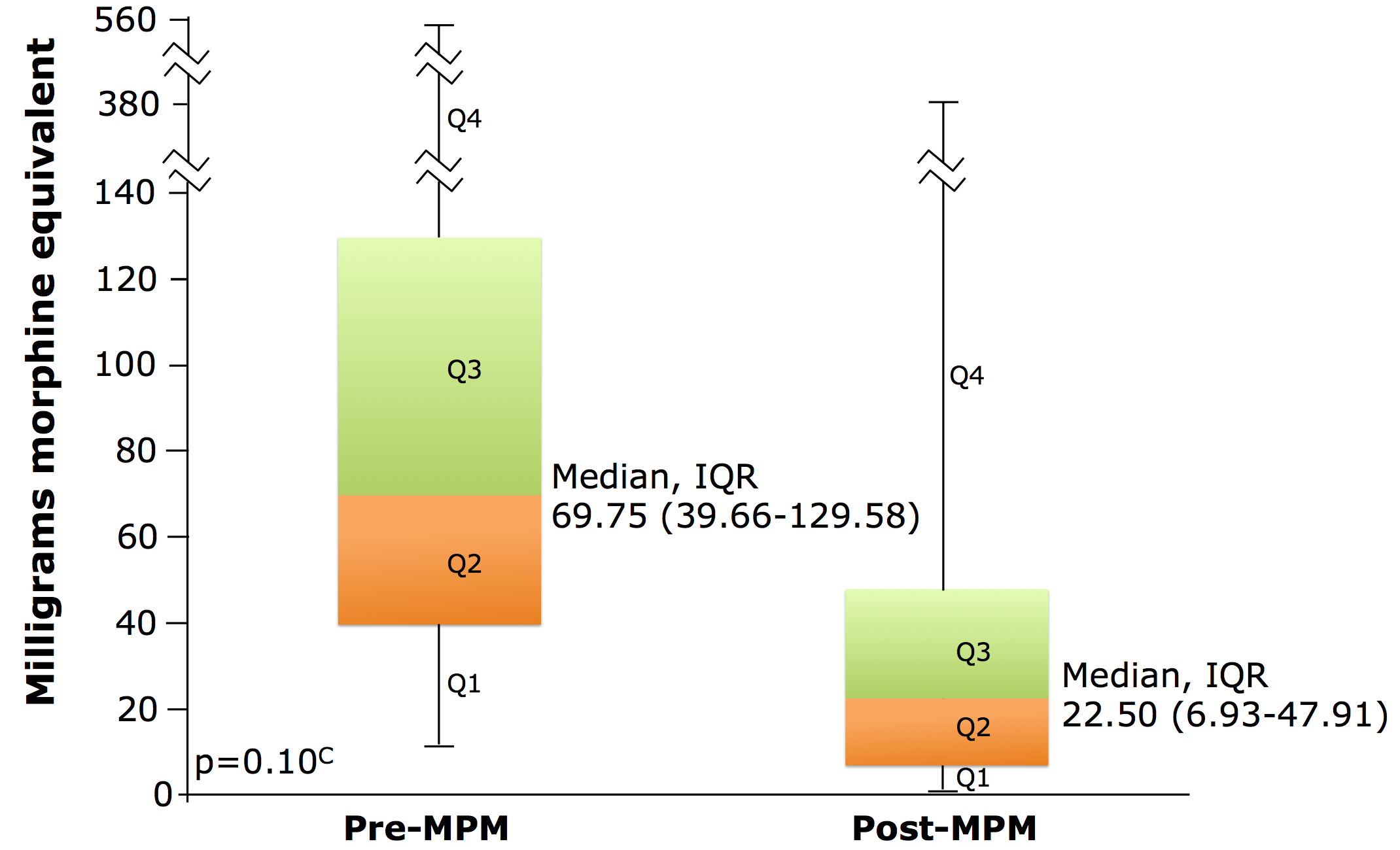Multimodal Analgesia Reduces Opioid Use after Liver Transplantation
Hartford Hospital, Hartford, CT
Meeting: 2019 American Transplant Congress
Abstract number: B319
Keywords: Liver transplantation, Pain
Session Information
Session Name: Poster Session B: Liver Retransplantation and Other Complications
Session Type: Poster Session
Date: Sunday, June 2, 2019
Session Time: 6:00pm-7:00pm
 Presentation Time: 6:00pm-7:00pm
Presentation Time: 6:00pm-7:00pm
Location: Hall C & D
*Purpose: The study aimed to determine if multi-modal pain management (MPM) can reduce opioid use in patients post-liver transplant.
*Methods: This was a retrospective review of liver transplant recipients from 8/20/2016 to 7/31/2018. Of 44 cases screened for inclusion, 11 were excluded for simultaneous liver-kidney transplant, pharmacy pain consult, or intra-operative death. Twenty patients were admitted prior to MPM launch on 1/18/2018 and received provider-guided pain management, while 13 patients were admitted after MPM launch and received scheduled acetaminophen 650 mg every 6 hours and gabapentin 300 mg every 8 hours (renally adjusted) with opioids only for breakthrough pain. Categorical binomial data were analyzed using the Chi-squared or Fisher’s test. Continuous data were compared using Mann-Whitney U or Student’s t-test. All tests of statistical significance set α=0.05.
*Results: Pre- and post-MPM patients had no statistically significant differences in baseline characteristics. Post-MPM patients received 47.25 fewer morphine milligram equivalents (MMEs) per day than pre-MPM patients (median; IQR 22.5; 6.93- 47.91 versus 69.75; 39.66-129.58, respectively, p=0.010). Pre-MPM patients had a shorter overall length of stay (LOS) (7.2 ± 2.3 versus 10.4 ± 4.7 days respectively, p=0.038) and ICU LOS relative to post-MPM patients (3.2 ± 2.0 versus 4.8 ± 2.6 days, p=0.0498). However, the post-MPM group may have had more complex clinical courses, supported by a trend towards longer time to final extubation. There was no statistical difference between pre- and post-MPM average MMEs prescribed outpatient (median; IQR 22.04; 10.00-46.88 versus 25.00; 0-49.17, respectively).
*Conclusions: Use of MPM significantly reduced opioid use after liver transplant. Our results provide a compelling rationale to further investigate the use of a non-opioid centered strategy to optimize pain management in this population.
| Pre-MPM | Post-MPM | P value | |
| Reintubated, n (%) | 1 (5.0) | 3 (23.1) | 0.276 |
| Days to final extubation (median, IQR) | 1 (1 – 2) | 2 (1 – 5) | 0.057 |
| ICU LOS (mean±SD) | 3.2 ± 2.0 | 4.8 ± 2.6 | 0.0498 |
| Total LOS (mean±SD) | 7.2 ± 2.3 | 10.4 ± 4.7 | 0.038 |
| Post-extubation LOS (mean±SD) | 5.6 ± 2.3 | 7.2 ± 3.3 | 0.152 |
| Pre-MPM | Post-MPM | P value | |
| Age, years (mean±SD) | 58.2 ± 9.2 | 54.4 ± 11.7 | 0.294 |
| Male, n (%) | 16 (80) | 10 (76.9) | 1.000 |
| Opioid tolerant, n (%) | 1 (5.0) | 1 (7.7) | 1.000 |
| Substance use disorder, n (%) | 15 (75) | 5 (38.5) | 0.067 |
| MELD Score (mean±SD) | 20.2 ± 8.3 | 18.8 ± 9.2 | 0.645 |
To cite this abstract in AMA style:
Tong K, Nolan W, O'Sullivan D, Kutzler H. Multimodal Analgesia Reduces Opioid Use after Liver Transplantation [abstract]. Am J Transplant. 2019; 19 (suppl 3). https://atcmeetingabstracts.com/abstract/multimodal-analgesia-reduces-opioid-use-after-liver-transplantation/. Accessed December 15, 2025.« Back to 2019 American Transplant Congress

